Comparing Hogweed Heracleum Species
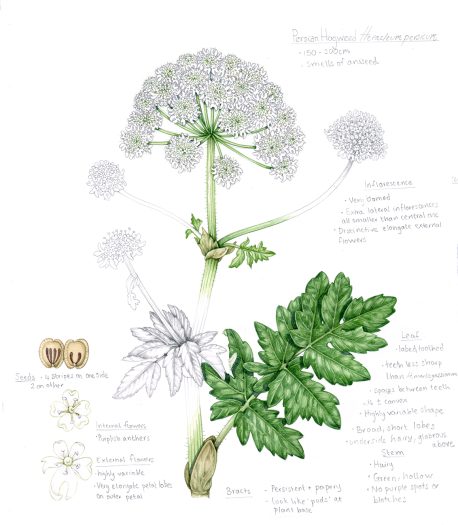
A recent job involved trying to show the differences between two species of invasive hogweed, Persian hogweed Heracleum persicum and Giant hogweed Heracleum mantegazzianum.
This blog sets out to share what these distinctions are.
Similarities
These plants are both large members of the Apiaceae, or carrot family. They have big lobed, dissected leaves, and a froth of tiny white flowers borne at the top pf their thick, ridged and hollow stems. Leaves are opposite, and there tend to be more toward the base of the plant. There’s wide variation in leaf shape for both plants.
The flowers are in terminal clusters known as umbels. Each individual flower is tiny, with five petals. Outermost flowers have elongate petals which point away form the flower cluster.
There are about 50 different hogweeds in the Apiaceae family, and these ones are of interest because of their status as invasives.
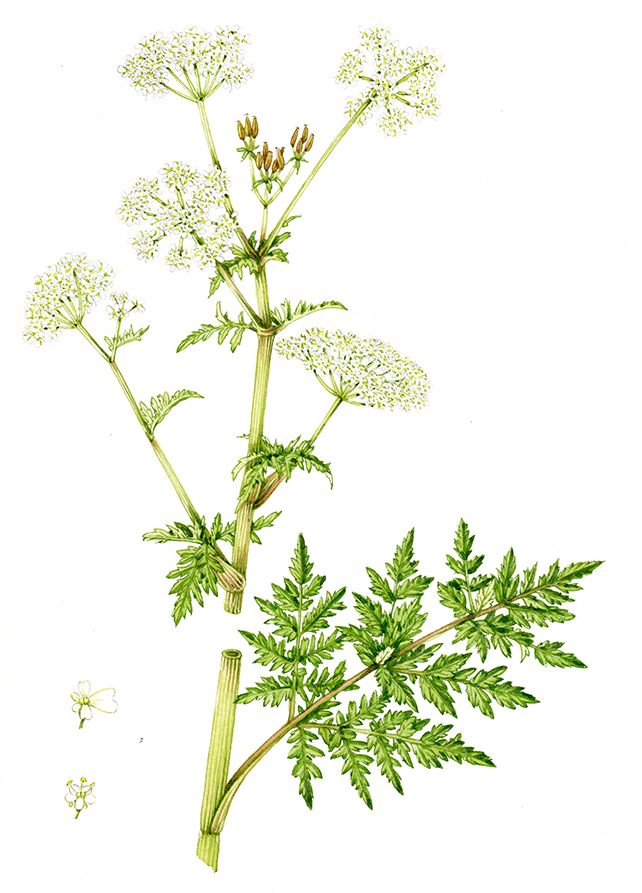
Cow Parsley Anthriscus sylvestris (Another Apiaceae, not a hogweed)
Cow-parsley is another plant in this family which includes carrot, celery, hemlock, fennel, chervril, pignut, and even sea holly. Both our hogweeds are perennials, which means they live more than two years, and both are troublesome invasive species in Scandinavia.
Size
The easiest way to tell these two similar plants apart is with a ruler! Giant hogweed is significantly taller than Persian hogweed; its average height is around 3.5 m. It’s been known to grow up to 5.5 metres tall!
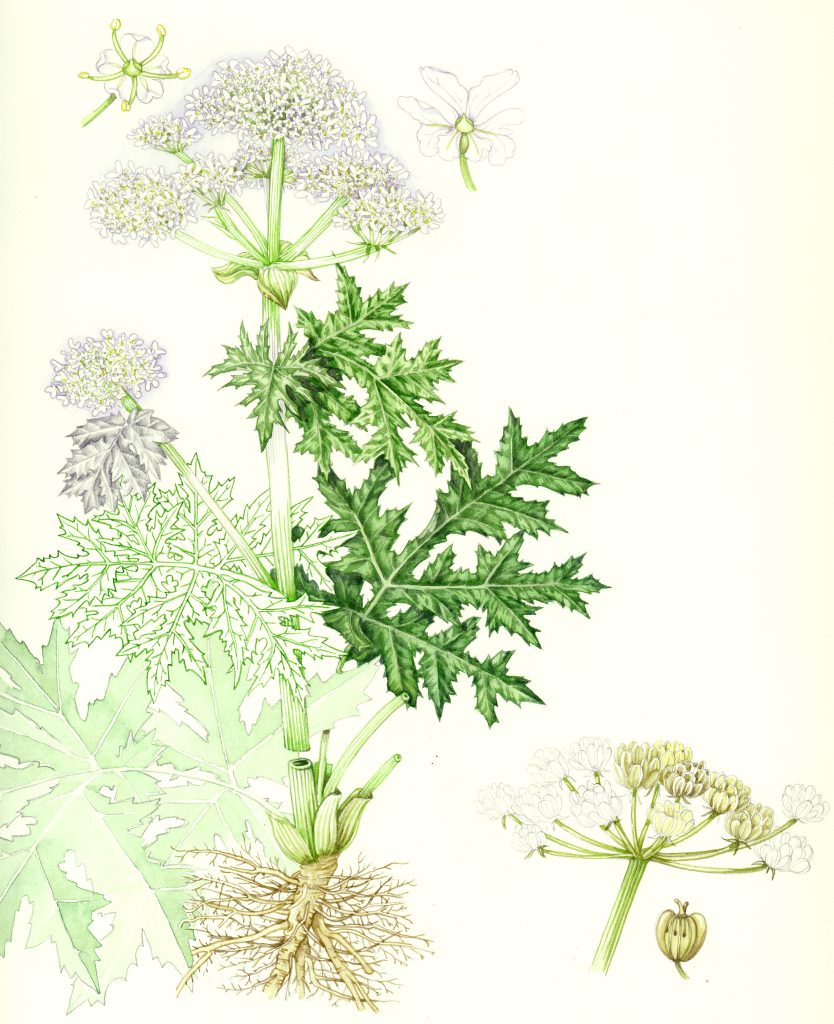
Giant hogweed
Persian hogweed is by no means tiny, it averages 1 to 2 metres in height, with maximum height around 3 m.
Below is a scale illustration to give some sense of this difference, showing a grown man of 180 cm.
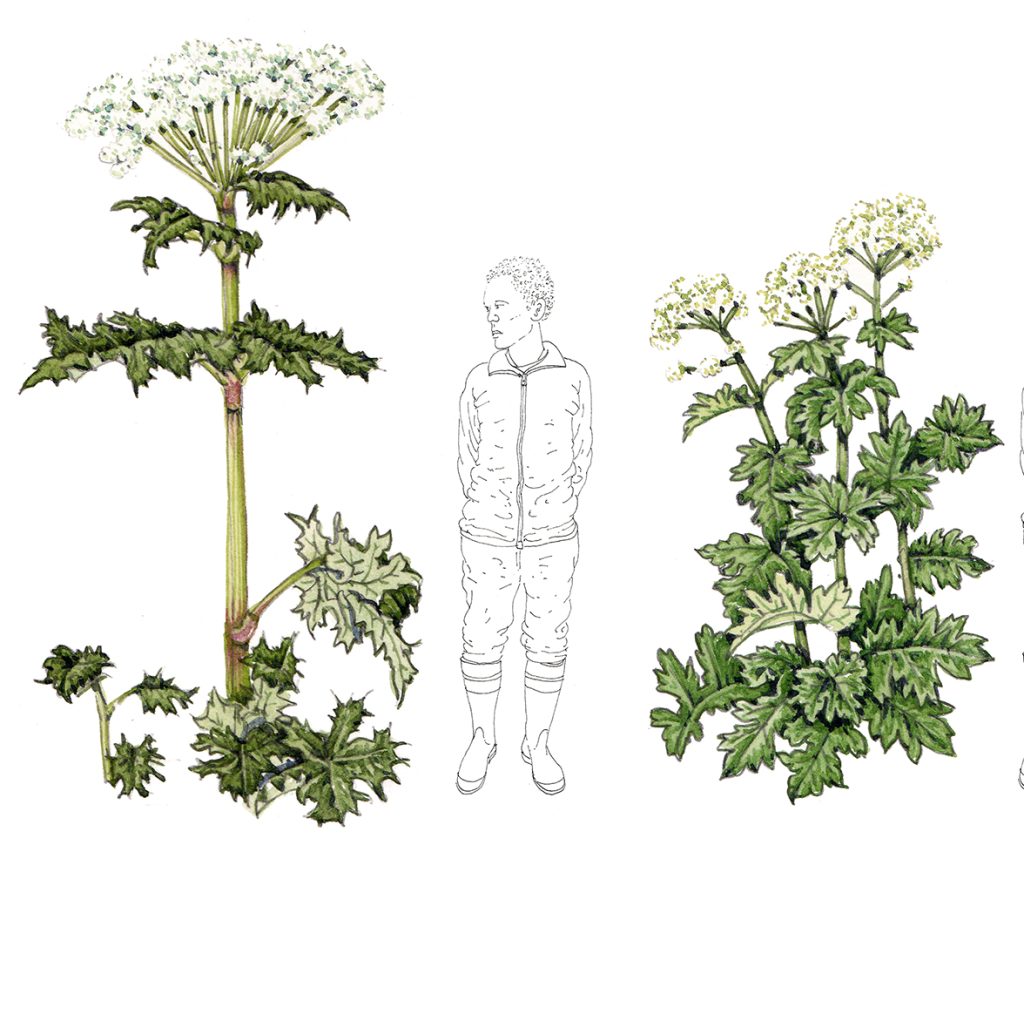
Comparison of the size of the Giant hogweed (on the left) and Persian hogweed (on the right)
Leaves: Giant Hogweed
As soon as we start talking about the differences between leaf shape we get into tricky territory. I was commissioned to do these illustrations in winter, so was relying heavily on photos and other illustrations. What I would have given for actual leaves from these plants!
Size plays a role here. The Giant hogweed leaves can measure up to 3 m long, and be 1.7 m wide. Although large, those of the Persian hogweed are smaller.
Leaflets are borne in opposite pairs with one terminal leaf (pinnate) and each leaf tends to have three to five leaflets.
There’s masses of variation in Giant hogweed leaves. Younger ones can be pinnate or almost round. Larger ones vary considerably in size and shape, depending on environmental conditions.
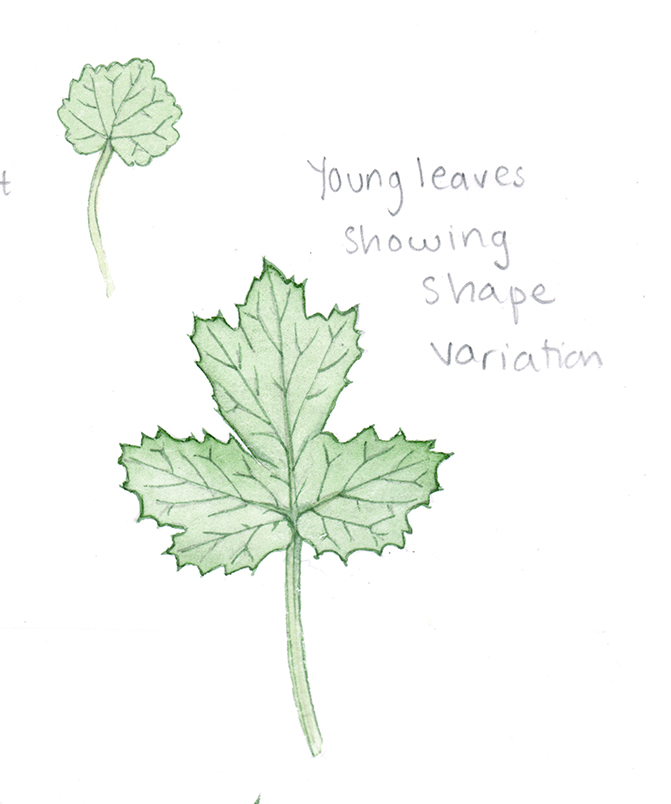
Variety in shape of young Giant hogweed leaves
Giant hogweed leaves feel spikier than those of the Persian species, and have more acute tips to the leaf lobes. They are densely hairy below, and glabrous above. Leaves are sharply dissected, and the lobes are long and narrow. The literature suggests that the teeth of the leaves have more or less concave sides. As with the young leaves, there’s a lot of variation in leaf shape.
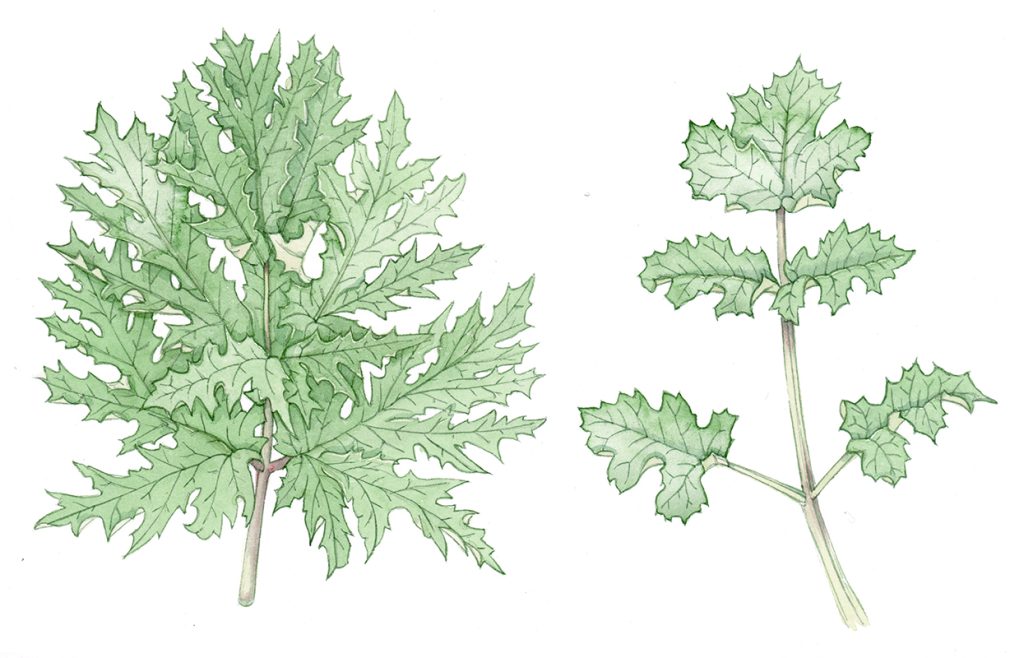
Variety of mature leaf shapes of Giant hogweed
Leaves: Persian Hogweed
Persian hogweed leaves feel a little softer, a little rounder. They’re up to 2 m long. The lobes are broad and short, and tend to have blunter tips than those of the Giant hogweed.
There are two to four pairs of serrated leaflets per leaf.
Leaves are hairy below and glabrous above. The teeth are said to have more or less convex sides. Once more, there’s a whole lot of variation even between leaves on a single plant.
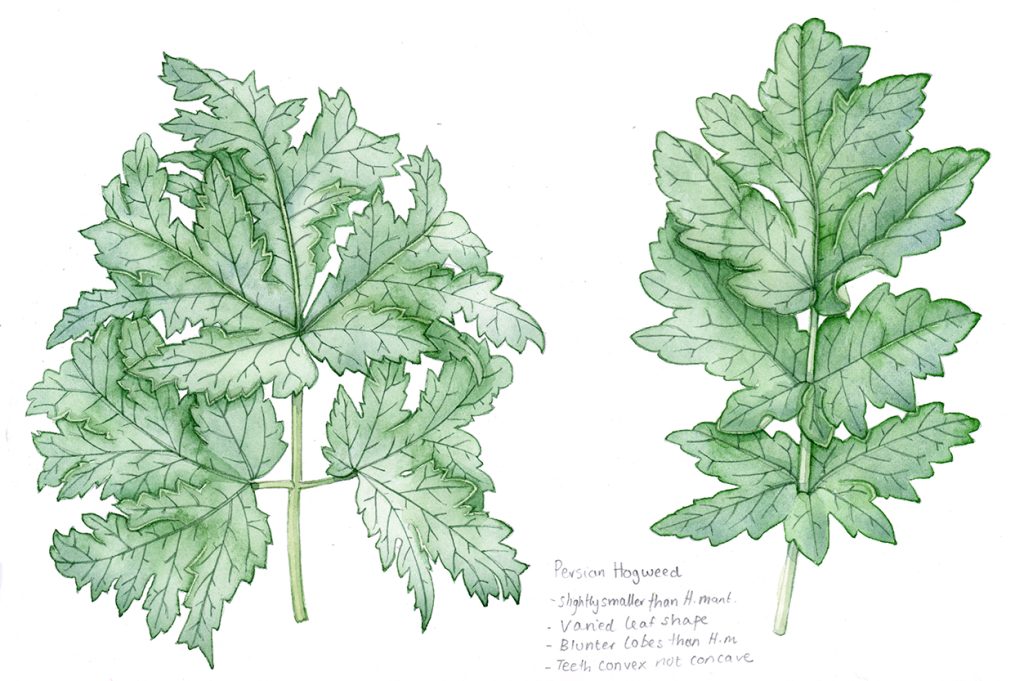
Variety in mature leaves of Persian hogweed
Stems: Giant hogweed
The stems of Giant hogweed are flushed crimson on the leaf petioles, and blotched red on the stems. Sometimes these spots are raised, and in many cases have a hair or bristle growing from each one. Stems can be large, up to 10 cm in diameter.
The stems are bristly, with a concentration of stout hairs forming a ring just below the petiole.

Detail of stems from Giant hogweed
Younger stems are also spotted dark crimson.
Giant hogweed has a distinctive pale yellow root. I was unable to find information on the colour of the Persian hogweed root, apologies.
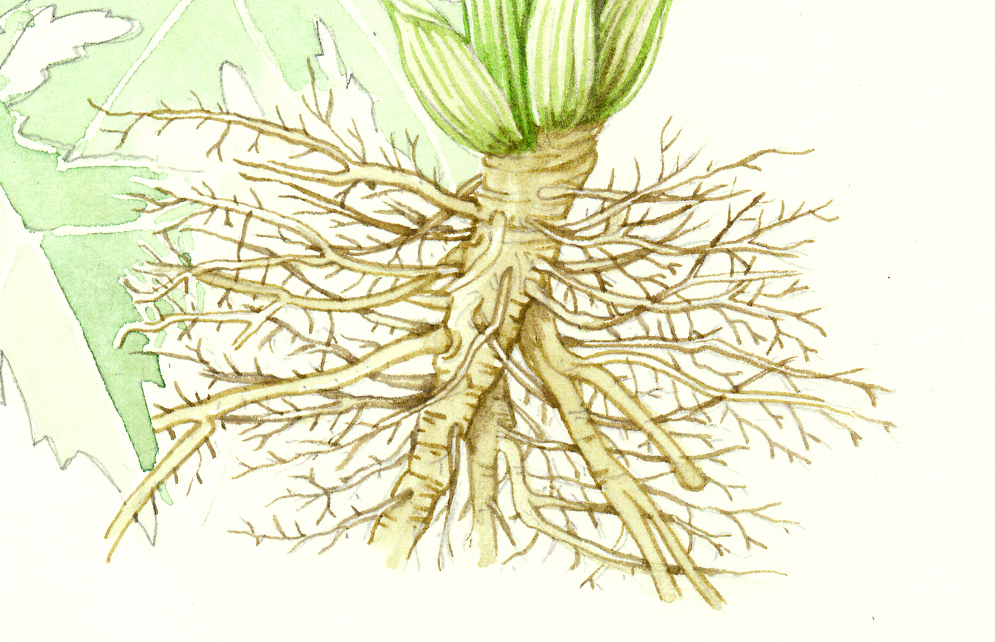
Detail of the root of Giant Hogweed
Stems: Persian hogweed
A major distinction between the two species (which I only learnt whilst researching this blog, alas!) is that Persian hogweed can have multiple stems.
Stems of Persian hogweed have less crimson botches, and may be only faintly flushed with red. Most of this colouring is towards the base of the plant. When present, the flush makes the stems appear a uniform brown colour. Many will have purely green stems.
These stems are more sparsely hairy, and the hairs are less coarse. The distinctive annulus of hairs below the petiole may be absent. Width wise, Persian hogweed stems are thinner than those of the Giant species.
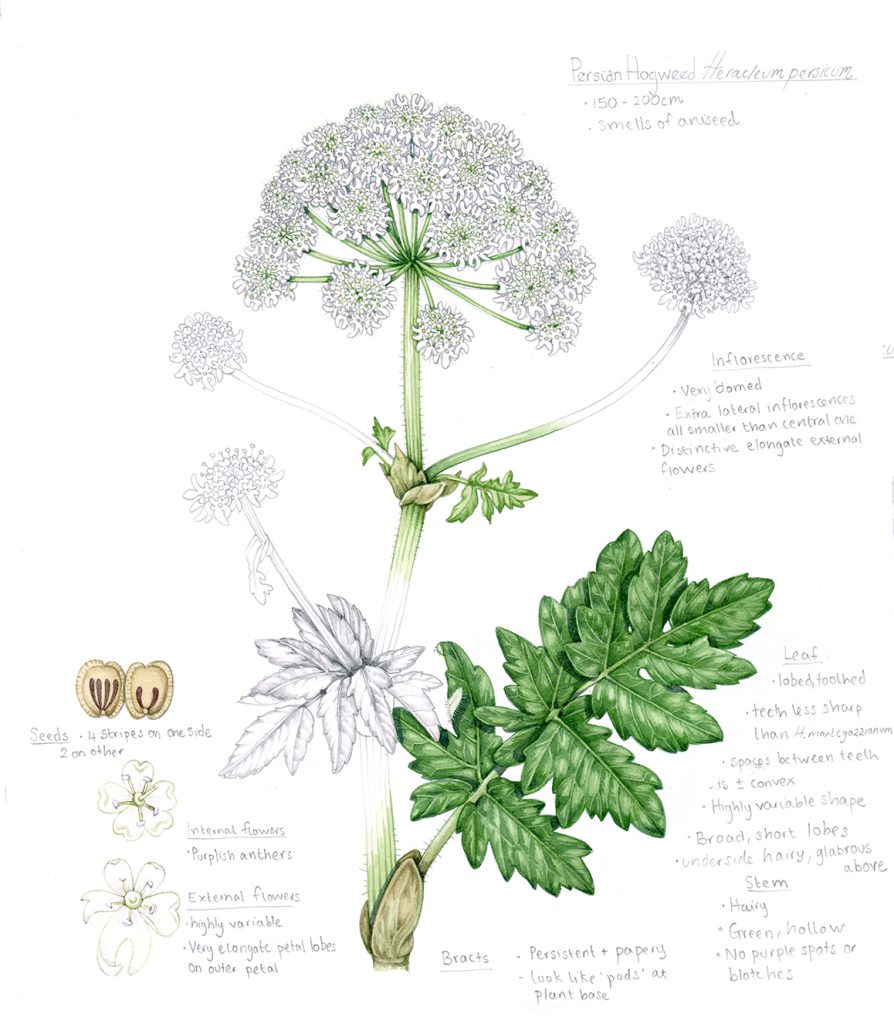
Persian Hogweed
Reproduction and Seeds
Both plants are perennial. Giant hogweed lives three to five years, and is monocarpic. This means it flowers, sets seed, then dies. Plants are able to reproduce from three years of age. One plant produces an average of 50, 000 seeds, each of which is viable for seven years. Plants can produce as many as 100,000 seeds.
Persian hogweed is also able to reproduce at three years old. Unlike the Giant hogweed, it is polycarpic which means it can set seed repeatedly. One plant can produce 80, 000 seeds per season.
The whole Persian hogweed plant is said to smell strongly of aniseed. Although Giant hogweed has an aromatic scent, it isn’t reminiscent of aniseed.
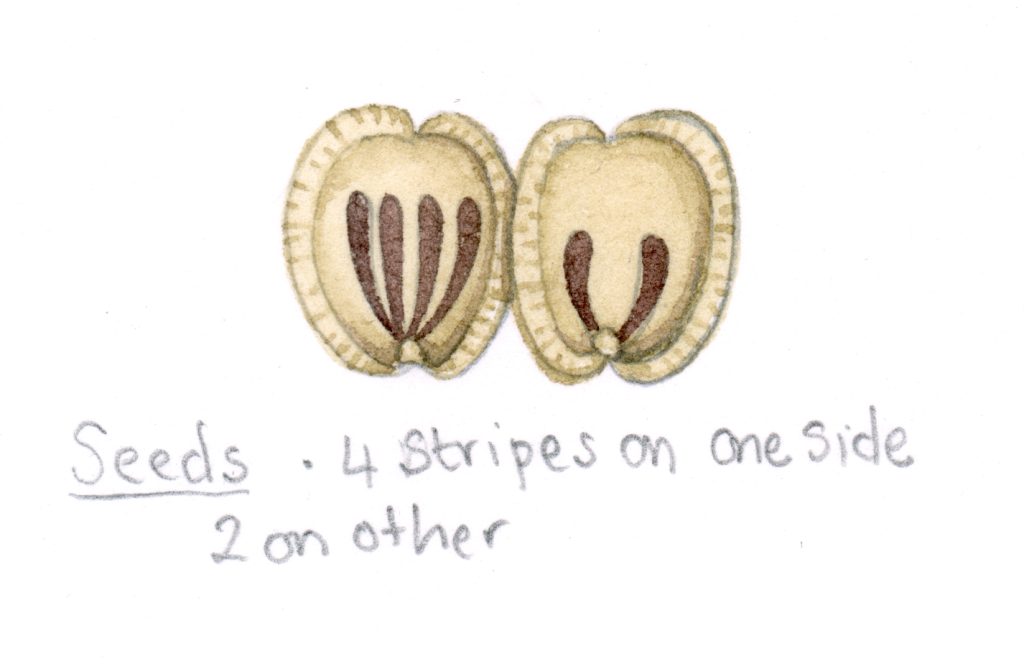
Persian hogweed seeds
Seeds of these plants look similar. They’re known as schizocarp (for more on types of seed, check out my earlier blog) and have two parts. They have papery margins and obvious oil-glands that look like dark stripes. There are two on one side, four on the other. In Giant hogweed these glands look club-shaped; less so in Persian hogweed. Both seeds are quite thin, and ridged. However, the ridges of Persian hogweed are a little more pronounced than Giant hogweed. Giant hogweed seeds are about 1.5 cm long whereas those of the Persian hogweed are a smaller 7-8 mm.
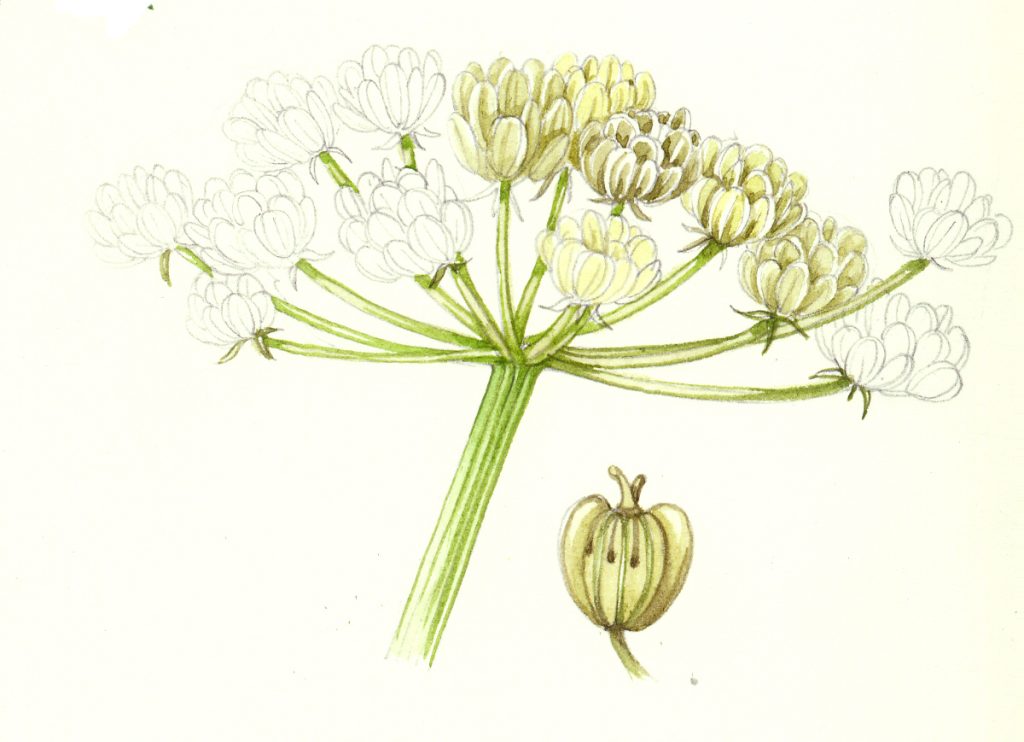
Seedhead and single schizocarp from the Giant hogweed
It’s worth noting that the seeds of the Persian hogweed are used as a spice in Persian cooking, specifically in making Golpar. They’re mostly sold in powdered form and have a bitter, aromatic flavour.
Flowers
This was a really tricky area to untangle, and several sources directly contradict one another when describing the overall shape of the flowering umbels of these two plants. The National Biodiversity Data Centre Ireland claims that Giant hogweed umbels are rounder than those of Persian hogweed; whereas several other sources such as Q-bank claim the opposite. My reliable British Flora (one by Stace; one by Clapham, Tutin and Moore) are silent on the matter.
An update to the blog: I’ve just had information from Lars Froberg, a Swedish botanist who knows a great deal about Umbellifers. He categorically states that the Persian Hogweed has a more domed flowering head than the Giant Hogweed.
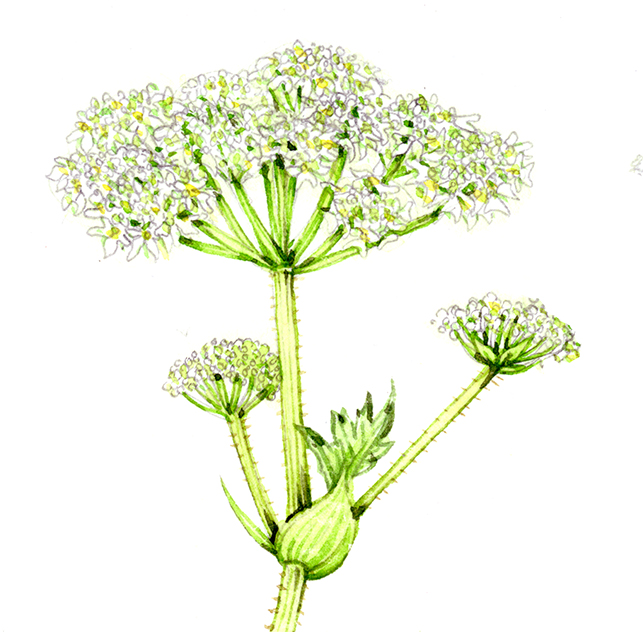
Main or central umbel of Giant hogweed
Therefore, accept my apologies in advance if my summary below isn’t perfect.
Both these umbellifers have frothy flowering heads of tiny white flowers, each bearing five notched petals. Each flower has five stamens, five sepals, and a pistil of two fused carpels, and two styles. The central or main umbel has bracts which swiftly fall off, the bracteoles of secondary umbels are persistent.
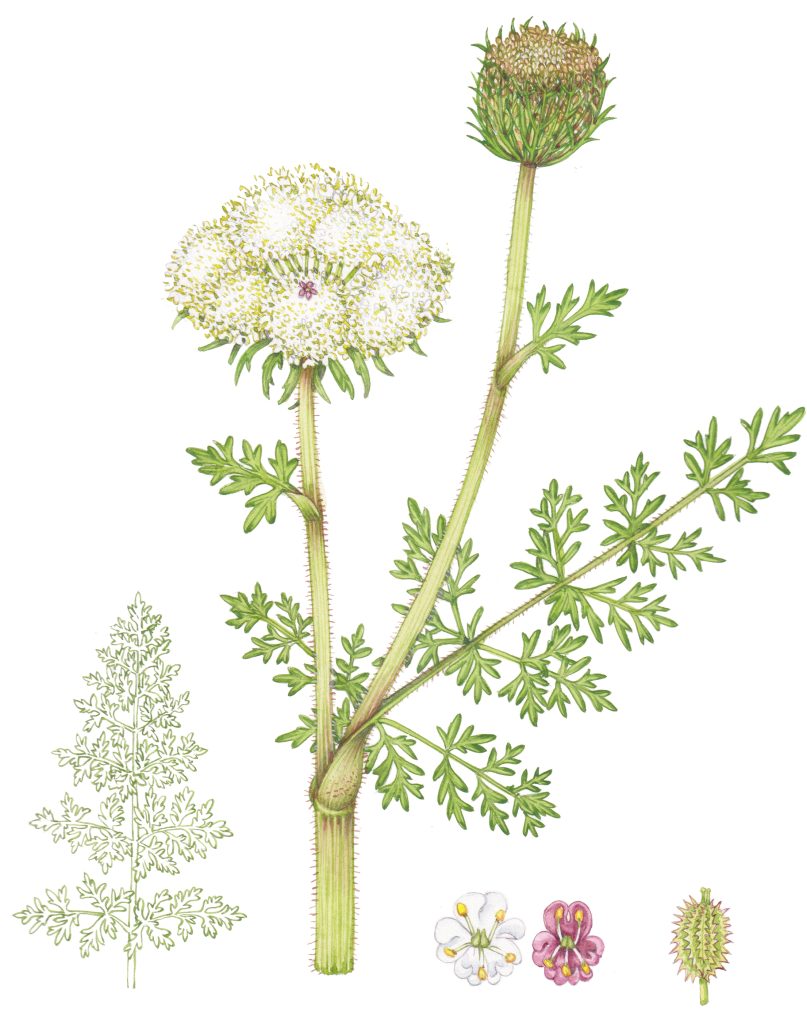
Another Apiaceae species; the Sea Carrot Daucus carota gummifer
Both species flower (in Scandinavia) between July and September, although Persian hogweed will bloom a little earlier on average.
Flowers: Giant Hogweed
Giant Hogweed bears its flowers in a somewhat flattened inflorescence. These flowering heads are broad, measuring up to 80 cm across.
There are 60 – 120 rays per inflorescence.
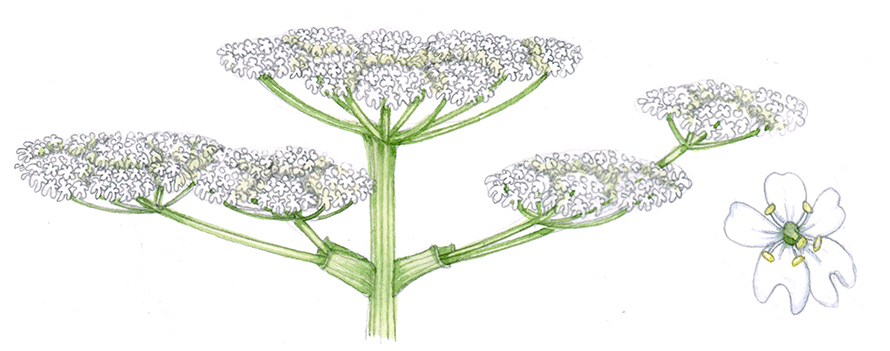
Giant Hogweed with an exaggeratedly flattened inflorescence
As with many Apiaceae species, the outermost flowers are zygomorphic, or differently shaped to those further within the cluster. Their outermost petals are slightly longer than the rest, and are deeply notched.
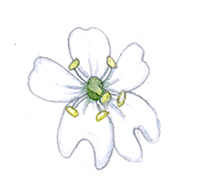
Single exterior flower from Giant hogweed
Flowers: Persian Hogweed
The Persian hogweed has domed umbels of flowers. As with the Giant hogweed, flowering heads can be 80 cm across.
There are 35 – 85 rays per inflorescence.
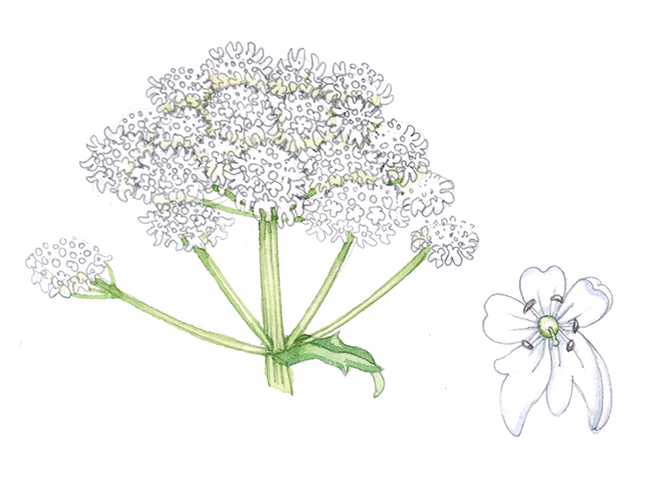
Persian hogweed with an exaggeratedly domed inflorescence
The side branches seem to matter here. They bear flowering heads which are significantly smaller than the central umbel; this isn’t true of Giant hogweed where side branches can produce umbels almost as large as the main flowering cluster.
The external flowers are zygomorphic, in this case they have really long outer petals. This gives the edges of the umbels a feathery look, and if you take a close look at an individual flower is really distinctive.

Putting all this information together gives you the following comparison:

Persian hogweed (on the left) and Giant hogweed (on the right).
Other similar species
Although the size of these two plants makes them instantly distinguishable from other members of the carrot-family, there can be confusion.
Repeated trampling, cutting, or grazing can reduce their final adult size.
Hogweed Heracleum sphondylium and the subspecies Heracleum sphondylium sibericum can look similar to the Giant and Persian hogweeds. Their maximum height is 2 m, but most are 1 m or less. Stems don’t exceed 2cm in diameter. Leaves are no longer than 60 cm and are less deeply divided than those of our hogweeds. The flowering umbels rarely exceed 20cm.
Sosnowsky’s hogweed Heracleum sosnowskyi is another invasive in Finland, and can grow to 5 m! It differs from the other two in having rounder leaf lobes and has 30 – 150 rays per umbel. From the images online, it seems to have a pronounced and domed flowering head.

Hogweed Heracleum sphondylium
Saying that, there are problems with species identification, as our hogweeds have been known to cross-breed and create hybrids.
Conclusion
My main conclusion is that telling the difference between similar members of the cow-parsley family can be super-tricky, especially when references and sources disagree!
Both plants are enormous, and have these white frothy flowering heads.
Both can be killed off by repeated ploughing and cutting back, or gyphosphate pesticide. Grazing can help eradicate them, although it makes milk taste acrid. And interestingly, both can suffer from infestations of Celery beetle Phaedon tumidulus (celery’s another member of the Apiaceae family, so this makes sense).
Both plants are massively problematic invasive species, and are notifiable in several countries.
Differences can be found in the colouring and hairiness of the stem, the scent, and the shape of the umbels and outer flowers, and in the seeds. The leaves are a good place to start. Spikier and deeply serrated is likely to be Giant hogweed. Rounder and with convex teeth and you’re probably looking at a Persian hogweed. Or a hybrid!
Many thanks to FOR Sweden for asking for clarification from Lars Froberg; now these differences have his seal of approval I feel much more confident about the content of the blog and of my illustrations.

Resources
As a result of my struggles with this job and blog, I’ve not only ordered a copy of Tutin’s Guide to Umbellifers of the British Isles, but have also booked myself on a day-long course on identifying Apiaceae. I’m ready to learn, and equally ready to be massively confused!
Resources used include the Encyclopedia of Life; Giant hogweed and Persian hogweed pages; and Naturespot. The National Biodiversity Data Centre Ireland had good sources of information on both Giant and Persian species. Naturegate had good information on both species; and the Woodland trust was also useful.
For a fabulous visual comparison of hogweeds, check out the link to Q-bank.
Books included the aforementioned Stace and Clpaham, Tutin & Moore British Floras, alongside Collins Flower Guide by David Streeter. Importantly, and especially if you read Swedish, Lars Froberg recommends looking at Flora Nordica, volume 6. The two species are described in this volume, and he is the author of the chapter on Heracleum species.
Here’s a short film of me discussing the differences between these two species.
These original illustrations are mostly available to buy. Have a browse in the Original unframed sketchbook illustrations and Original unframed plant illustrations section of my website, using the search facility.
For other blogs comparing invasive species (namely the Lupin and Goldenrods) check out my earlier blogs.


Very helpful. Thank you!
Beautiful work.
My pleasure! Thanks for leaving a comment
Appreciating the time and effort you put into your site and in depth information you provide.
It’s great to come across a blog every once in a while that isn’t the same
unwanted rehashed material. Fantastic read! I’ve bookmarked your site and I’m adding your RSS feeds to my Google account.
Thanks!